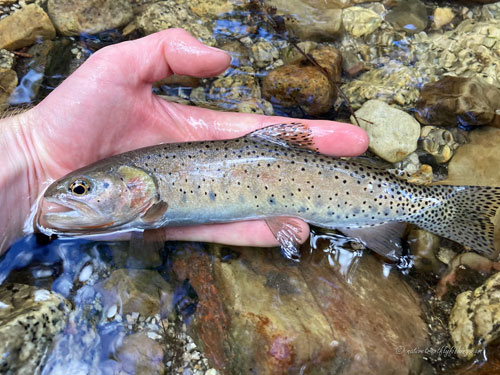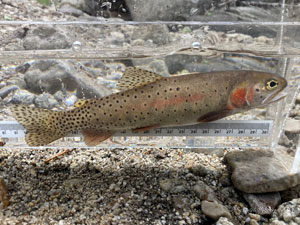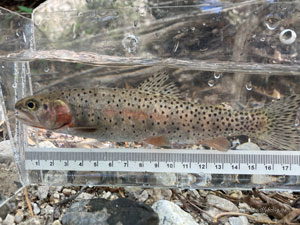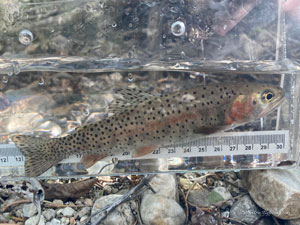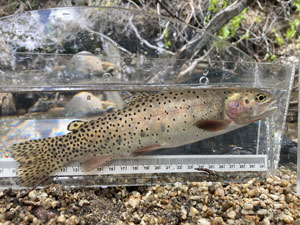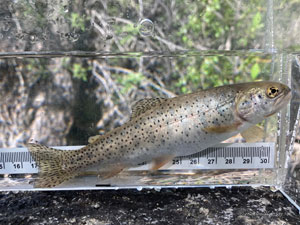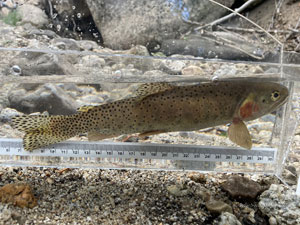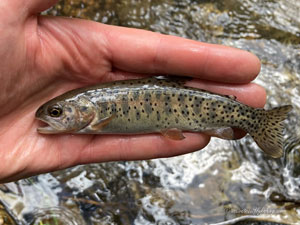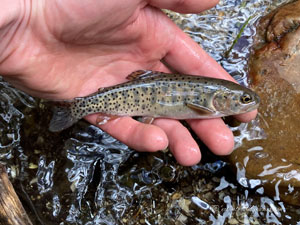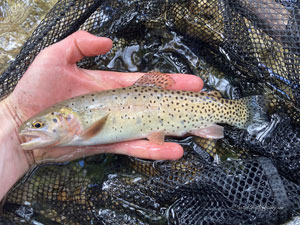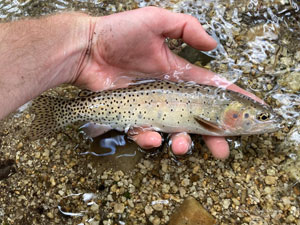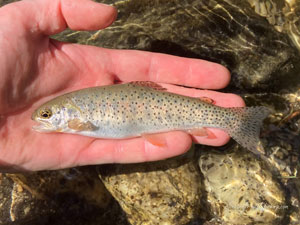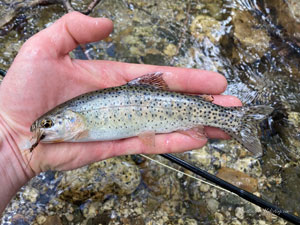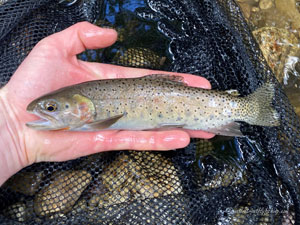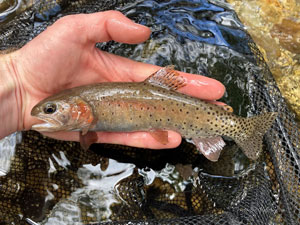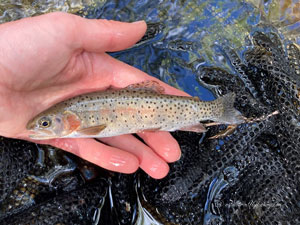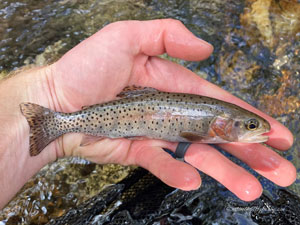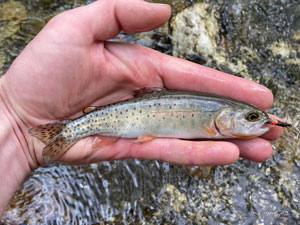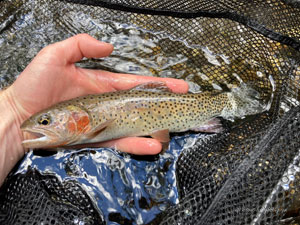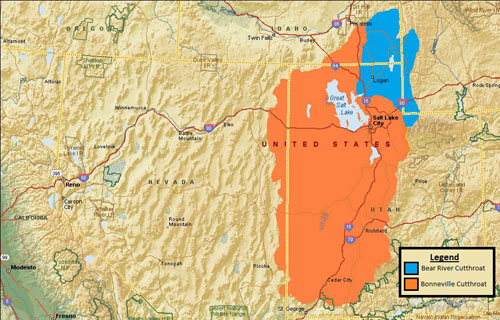Bonneville Cutthroat
Oncorhynchus virginalis utah
A Bonneville Cutthroat from a small stream on the western side of the Bonneville Basin.
Introduction
Bonneville Cutthroat are a subspecies of Rocky Cutthroat Trout native to the Bonneville Basin of Utah and Nevada (Trotter et al. 2018). Bonneville Cutthroat were originally named Salmo utah in 1874 based on specimens from Utah Lake (Suckley 1874). Historically, the Bear River Cutthroat were lumped in with the Bonneville Cutthroat Trout as a single subspecies, but genetic information indicates that the two forms of Cutthroat are genetically distinct (Behnke 1992, Behnke 2002, Trotter 2018). Bear River are most closely related to Yellowstone Cutthroat, while Bonneville Cutthroat, appear to be more closely related to Colorado River Cutthroat (Campbell et al. 2018). Bonneville Cutthroat adapted to life in ancient Lake Bonneville which was the largest of the Great Basin lakes and was at its greatest extent during the last ice age, when it reached a surface area of 20,000 square miles (51,000 square km) and overflowed into the Snake River (Mifflin and Wheat 1979). Today all that is left of the Lake Bonneville is the Great Salt Lake and Utah Lake and most extant populations of Bonneville Cutthroat are found in small, isolated streams along the fringes of the basin. In additional to the populations within the Bonneville Basin, there are also several remnant Bonneville Cutthroat populations within the current native range of the Yellowstone Cutthroat. These populations are found in a handful of small streams in the Raft and Portneuf River drainages and Idaho, relicts of when ancient lake Bonneville overflowed into the Snake River drainage during the last ice age (Link et al. 1999, Campbell et al. 2018, Eaton et al. 2018). The Weber River, Utah also appears to be a zone of contact, with both Bear River and Bonneville genotypes present, although the Bear River lineage appears to be dominant in the watershed (Houston et al. 2013). The two potential invasion routes for Bear River Cutthroat into the Weber River are either from the south via Lake Bonneville, or due to a partial stream capture from Yellow Creek which drains to the upper Bear River. Additionally, there are two populations of Bonneville Cutthroat Trout found in the headwaters of Santa Clara watershed, in Virgin River drainage (tributary to the lower Colorado River). These populations are of uncertain origin, but accounts of abundant populations of trout in the Santa Clara watershed date back to 1859 only four years after the first pioneers arrived. It is currently believed that these trout colonized the Santa Clara River after volcanic activity diverted Grass Valley Creek into the drainage around 2,000 years ago (Hadley et al. 2011). There is also some evidence that Bonneville Cutthroat were once found in the North Fork Virgin River at one point, but it is worth noting trout were not found in early fish collections in the Virgin River watershed (Behnke 1979).
Life History Information
As with most subspecies of Cutthroat, the Bonneville Cutthroat historically expressed stream resident, fluvial and adfluvial life history strategies to take advantage of different habitats across their native range. However, the only remaining pure populations today are derived from small streams where the fish exhibited stream resident life histories, as the original adfluvial and fluvial populations were all lost over the last century.
Stream Resident and Fluvial (River Migrant) Life History
Stream resident populations of Bonneville Cutthroat historically were found in most cooler streams along the fringes of the Bonneville basin, while the Weber, Sevier, Spanish Fork, Jordan, and Provo rivers all once held fluvial populations. While the Weber River still holds a fluvial population, it is a mixed population of Bear and Bonneville Cutthroat (Houston et al. 2013) and unfortunately, the pure fluvial populations of Bonneville Cutthroat have been all but lost and the remaining populations primarily exhibit a stream resident life history. Due to the variable environmental conditions of the Bonneville Basin and long isolation between the different populations of these trout, they have adapted to a wide range of habitats across their native range, running the spectrum from small cold alpine streams to arid streams prone to low flows and warm water temperature. In stream resident populations growth is slow and as such these Cutthroat are opportunistic feeders. Stream resident Bonneville Cutthroat primarily preying on aquatic and terrestrial invertebrates, with aquatic insects dominating the diet in early summer and terrestrial insects (primarily ants) accounting for over 50% of the diet in the late summer and fall (Hickman 1977). The maximum size of stream resident Bonneville Cutthroat varies greatly depending on the productivity of the streams that they reside in, but they typically reach a maximum size of 8 to 12 inches (20 cm to 30 cm) (Trotter 2008). Fluvial fish were historically able to reach much larger sizes and fish in the Provo River were reported to have reached lengths 26 (65 cm) and weights of 5 lbs. to 6 lbs. (2.3 kg to 2.7 kg) (Yarrow 1874). Stream resident Bonneville Cutthroat in a small headwater stream in Utah typically reach sexual maturity at age-2 for males and age-3 for females, with spawning occurring from May through June (Hickman 1977, May et al. 1978). Fecundity is typically low in stream resident females, with fish between 6 to 7 (15 cm to 18 cm) producing 100 to 175 eggs (May et al. 1978).
While historic pure populations of fluvial Bonneville Cutthroat were lost, the mixed population of Bear River and Bonneville Cutthroat in the Weber River may provide some insight into the life history characteristics of these fish. Juvenile fluvial Cutthroat are typically spawned in tributary streams, where they rear for one to two years before migrating downstream to the mainstem Weber River. To illustrate this, Budy et al. (2020) showed that while tributaries are dominated by age-2 and younger fish, the mainstem Weber River is dominated by age-2 and older fish. Like stream resident fish, fluvial Cutthroat are generalist preying heavily on aquatic and terrestrial invertebrates, with fish also playing an important role in the diet of larger individuals (Behnke 2002, Trotter 2008). Fluvial fish achieve higher growth rates than resident fish in the tributary streams and the size of mature fluvial adults in the Weber River generally ranges from 12 to 20 (30 cm to 52 cm) (Budy et al. 2020). Most fluvial Cutthroat in the Weber drainage appear to only make short migrations of less than 2 miles (3 km), although some individuals have been documented migrating up to 16 miles (26 km) to reach their spawning streams (Budy et al. 2020). Spawners range from age-3 to age-8 and typically enter tributaries in April, with the spawning period continuing through early-June. Cutthroat Trout that survive spawning, generally return to the mainstem Weber River in early summer, where they forage throughout the rest of the growing season.
Adfluvial (Stream to Lake Migratory) Life History
The Bonneville Cutthroat adapted to life in ancient Lake Bonneville, where they are thought to have been the apex predators. As Lake Bonneville desiccated at the end of the last ice age, its largest remnant the Great Salt Lake became too salty to support Cutthroat Trout, but freshwater influxes in another remnant of Lake Bonneville, Utah Lake near Provo, Utah were enough to maintain a thriving Cutthroat population. After having survived the desiccation of ancient Lake Bonneville, the Bonneville Cutthroat that were left isolated in streams around the basin still bare the evidence of these events as they are able to tolerate the highest levels of salinity among Rocky Mountain Cutthroat subspecies, with no mortality recorded at levels that were lethal for Yellowstone, Snake River Finespotted and Bear River Cutthroat (Wagner et al. 2001).
When European explorers and settlers first arrived in the Bonneville Basin, the greatest population of adfluvial Bonneville Cutthroat was found in Utah Lake. These fish were noted for being very numerous and were an important food source for the native tribes (Knoll 2002). However, after pioneers arrived, a commercial fishery quickly arose, which along with habitat degradation and the introduction of non-native fish species effectively eliminated the Cutthroat within seventy-five years. Based on historical accounts, Utah Lake Cutthroat are believed to have gone extinct by the 1930's before any formal life history studies could be conducted (Tanner 1936, Trotter 2008). However, we do know a bit about these fish from early accounts and records from the fishery. Utah Lake Cutthroat were noted to utilize deeper waters during the winter and mid-summer but foraged extensively in nearshore waters during the spring and fall. In addition to using deeper waters in the summer, the Bonneville Cutthroat in the lake were also noted to congregate near the mouths of streams, which provided cold water refuges where they could forage and grow. Like Bear Lake Cutthroat, the trout of Utah Lake were thought to be long lived and were believed to not mature until age-5. Also, like Bear Lake Cutthroat, the Utah Lake Cutthroat were piscivorous, with their diet dominated by juvenile fish such as the Utah Chub. However, were also documented preying on aquatic and terrestrial invertebrates, snakes, and frogs (Yarrow 1874). While the average size of trout in Utah Lake was around 14 (36 cm), their age at maturity and feeding habits allowed them to reach much larger sizes. Historical accounts document that the fish reached lengths of 30 (76 cm) and weights of 15.5 lbs. (7 kg) (Yarrow 1874, Heckmann et al. 1981), although some sources suggest that they may have reached weights of 40 lbs. or more (Trout Unlimited 2016). As spawning neared, Utah Lake Cutthroat we noted for displaying brilliant colors and spawning runs started entering tributaries to the lake in mid-March and they were believed to remain in their spawning streams through mid-May (Yarrow 1874). Post spawning mortality was thought to be high, but those fish that survived were left their redds after spawning was complete and returned to the lake. Juveniles were not typically observed in the lake and as such it can be assumed that most juveniles remained in the streams for one to two years, as is observed in other adfluvial populations of Cutthroat.
In addition to Utah Lake, another native adfluvial population of Bonneville Cutthroat persisted in Panguitch Lake near the southern end of the Bonneville basin. The name Panguitch is derived from the Paiute Indian word for big fish and Panguitch Lake Cutthroat are said to have averaged 3 lbs, (1.4 kg) with some fish reaching several times that size (Trotter 2008). Unfortunately, like the population in Utah Lake, the native Cutthroat of Panguitch Lake were also lost and even less is known about their life history than the Utah Lake Cutthroat.
While the original adfluvial populations of Bonneville Cutthroat Trout were lost, some reintroduced populations as well as remnant stream resident populations have adopted adfluvial life histories in reservoirs across the Bonneville Basin and alpine lakes. Reintroduced and remnant populations of Bonneville Cutthroat in Manning Meadow, Mountain Dell, Little Dell and Red Butte Reservoirs are currently maintained as broodstock sources in Utah and consistently outperform other stocks of Cutthroat when stocked in arid lakes and reservoirs around Utah (Hepworth et al. 1999). The first of these adfluvial populations to be developed as a brood source for Bonneville Cutthroat was Manning Meadow Reservoir, which originated from a transplant of Cutthroat from Water Canyon, Reservoir Canyon (Santa Clara River drainage) and Birch Creek (Beaver River drainage) in 1990 and 1991 (Hepworth et al. 1997a). Bonneville Cutthroat thrived in Manning Meadow Reservoir after their introduction and by 1992 adult spawners started returning to the trap on Timber Creek and at the outflow of the reservoir (Hepworth et al. 2000). Additional brood sources of Bonneville Cutthroat were established in Mountain Dell and Little Reservoirs in 2001, after the remnant Cutthroat population in Mountain Dell Creek upstream of Little Dell Reservoir were determined to be a genetically pure population (Slater and Wiley 2008). The Cutthroat in these reservoirs are thought to be generalist, prey on aquatic and terrestrial invertebrates and fish once they are large enough, but no formal diet studies have been conducted. The average size of trout in Manning Meadow Reservoir is 15 (39 cm), with a weight of 1.6 lbs. (709 g) but fish up to 18.5 (47 cm) and 7 years old have been documented (Hepworth et al. 2004, Wagner and Oplinger 2013). Fish in Mountain Dell and Little Dell Reservoirs appear to reach slightly larger sizes and fish of up to 24 (61 cm) have been observed (Wagner and Oplinger 2013). Spawning in Manning Meadow and Mountain Dell Reservoirs typically takes place between late-May and mid-July and females have an average fecundity of 994 eggs in Manning Meadow and 1,722 in Mountain Dell Reservoir (Kershner 1995, Hepworth et al. 2004, Wagner and Oplinger 2013). Depending on when they were spawned, fry typically emerge from the gravel in mid to late summer and move into the stream margins shortly after emergence with juveniles moving into the lakes or reservoirs within their first two years of life (Kershner 1995). Another adfluvial population of hybridized Bonneville Cutthroat from the Provo River is found in Jordanelle Reservoir, but very little is known about this population at the present time.
Status
Bonneville Cutthroat have suffered significant declines across the Bonneville Basin since the arrival of Euro-Americans and are only starting to make a comeback thanks concerted efforts to protect and reestablish populations across their native range. The loss of Bonneville Cutthroat following the arrival of pioneers in the basin was rapid and so severe, that by 1950, it was assumed that they were extinct (Miller 1950, Cope 1955). The first hope that the Bonneville Cutthroat might not be extinct came in 1953, when an introduced population was discovered in Pine Creek, Nevada outside the native range, which was assumed to be a transfer from the nearby Snake Valley (Dodge and Cain 1971). Given that this was the only known population of Bonneville Cutthroat in existence, a few of these fish were reintroduced into two other streams in the Snake Valley, Nevada in 1953 and 1960 to safeguard the species. Shortly after, three additional pure populations of Bonneville Cutthroat were discovered in Birch Creek (extreme headwaters), Trout Creek and Hendrys Creek in the Snake Valley of Utah and Nevada (Hickman 1977, Hickman and Duff 1978). An additional three populations restricted to less than 5 miles (8 km) of habitat were also discovered in southwestern Utah in the 1970s (Hepworth et al. 1997b). This set off a chain of events to begin recovery the Bonneville Cutthroat throughout their native range. However, as recovery was slow and slightly haphazard and Bonneville Cutthroat continued to be threatened by a variety of factors across their native range, a petition was filed in 1998 to list Bonneville and Bear River Cutthroat under the Endangered Species Act (ESA) (USFWS 1998). However, in a rare case of forward-thinking conservation-based management, the states of Utah, Nevada, Idaho, and Wyoming came together to develop a range wide conservation plan to recover Bonneville and Bear River Cutthroat (Lentsch et al. 2000). This plan set a clear strategy and recovery goals for Bonneville Cutthroat and was a large part of the reason that the petition to list the Bonneville Cutthroat as threatened under the ESA was rejected by the U.S. Fish and Wildlife Service (USFWS 2008).
So, what led to the wholesale decline of a subspecies of Cutthroat Trout that was once abundant across nearly all of the suitable coldwater habitat in the Bonneville basin? As with other subspecies of interior Cutthroat, no single factor can be pointed too, but instead a myriad of issues contributed to the dramatic decline of these fish. The history of the Cutthroat in Utah Lake provides a case study of how over-harvest, habitat destruction and the introduction of non-native fish resulted in once thriving populations of these Cutthroat vanishing within a hundred years of the arrival of settlers in the Basin. Native Americans lived around Utah Lake for thousands of years (Knoll 2002), and early explorers described the lake as teeming with several kinds of edible fish including Cutthroat, which were eaten immediately or dried and used by the native throughout the year. When Mormon settlers arrived in the basin in 1847, they found the clear, cool waters of Utah Lake held a plentiful population of Cutthroat and a commercial fishery developed on Utah Lake and the Provo River by 1849 (Trotter 2008). As the Mormon population went from 6,000 in 1849 to 40,000 in 1860, the demand for fish increased, as did the intensity of the fishery. Given the importance of the Cutthroat and the unsustainable nature of the fishery, the government began regulating it in 1860, with the use of gill nets and fish traps on spawning streams being outlawed in 1862 (Heckmann et al. 1981). Unfortunately, the enforcement of fishing regulations was lax and by 1870, the declining catch was well documented and had fallen to just a third of its former level (Yarrow 1874). In addition to overfishing, spawning habitat was also becoming degraded and by 1874 all of Utah Lakes inlet streams had irrigation diversions on them, which significantly impacted the ability of adults to reach the spawning grounds and the recruitment of juvenile Cutthroat. Locals noted that young of the year Cutthroat were being turned out on the land as a result of the irrigation projects (Heckmann et al. 1981). The situation was so bad that in 1896, John Sharp, the state Game Commissioner stated Bonneville Cutthroat in Utah Lake were fast becoming extinct. He blamed pollution from sawdust, and agricultural runoff, loss through unscreened canals as well as illegal fishing activities such as the use of dynamite, seines, spears and grab-hooks during spawning season as the primary drivers (Heckmann et al. 1981).
As a result of the decline of the Cutthroat and the impacts to the quality of the fishery, Utah residents decided to turn to fish culture as a solution. This started with attempts to propagate Bonneville Cutthroat from the lake, with hatchery operations originally occurring on a small scale beginning in the 1860s. However, when the first state fish hatchery was authorized in 1899, operations were ramped up and approximately one million Cutthroat eggs were collected annually to both supplement the population and stock other waters, which also resulted in overmining the already struggling population for eggs (Singler and Singler 1986). In additional to native Cutthroat, by the late 1880s Introductions of nonnative fish into Utah Lake and the Provo River started, with at least 20 species beginning introduced by the 1950s. Among the most notable introductions in the lake were Black Bullhead (1871), Carp (1882), Channel Catfish (1888), Largemouth Bass, Yellow Perch, Bluegill and Green Sunfish (1890) (Sharp 1897, Heckmann et al. 1981, Singler and Singler 1986). These species became established in the lake and while they provided some catch, they also irrevocably changed the food web to that of a warm water dominated community. Non-native species were also stocked in the Provo River, with Brown Trout being introduced in the late-1800s and Rainbow Trout and Brook Trout in 1894 (Heckmann et al. 1981). The introduction of these three species marked the beginning of the end of the Cutthroat of Utah Lake and the Provo River. Both Brook Trout and Brown Trout are fall spawning fish, which allows their offspring to emerge earlier than those of native Cutthroat and thus provides them with a competitive advantage (Behnke 2002). Additionally, Brown Trout become highly piscivorous and often prey on juvenile Cutthroat and as a result Bonneville Cutthroat do not appear to be able to maintain long-term populations in the presence of Brown Trout (Belk et al. 2016). Rainbow Trout which spawn in the spring, readily hybridize with Cutthroat resulting in a loss of genetic integrity of populations and after repeated stocking an eventual replacement of the original Cutthroat population. As predicted by the state game commissioner in 1896, the Cutthroat of Utah Lake soon became extinct and last Cutthroat of a once thriving adfluvial population was caught in 1930 (Trotter 2008). While the Cutthroat in Utah Lake were lost, there are several small remnant populations of Bonneville Cutthroat in streams the Utah Lake basin. Additionally, although they have some hybrid influence, some Cutthroat in in the Upper Provo River currently utilize Jordanelle Reservoir to express and adfluvial life history. Is it possible that these populations represent some component of the original Utah Lake population? That is hard to say, as the museum specimens from Utah Lake have yet to be evaluated for viable DNA to compare against existing populations. However, with the rediscovery of the original Pyramid Lake Lahontan Cutthroat, perhaps someday the museum specimens from Utah Lake will be evaluated and a population of the original Utah Lake Cutthroat will be rediscovered somewhere in the Bonneville Basin.
The loss of the Bonneville Cutthroat in Utah Lake was emblematic of their decline across the basin and led to the assumption that the subspecies was extinct just a mere one hundred years after the arrival of Mormon settlers in the 1850s. However, as isolated populations were discovered across their native range, restoration efforts began in earnest and today Bonneville Cutthroat occupy around 500 miles (817 km) of habitat across approximately 100 populations (excluding the Weber drainage) (BCT 2019). Among the great conservation success stories for Bonneville Cutthroat has been efforts to restore populations in the Snake Valley. After the discovery of a handful of small remnant populations, this area was the epicenter for some of the earliest reintroduction efforts. At the onset of these reintroductions, non-native trout were established in nearly all of the streams in the Snake Valley, but after years of concerted efforts to treat these streams, Bonneville Cutthroat are now found 29 streams draining to the valley including nearly all of the streams in the Deep Creek Mountains.
Despite the successes, these restoration efforts have also had their hiccups, as many of these populations are located in small, isolated streams that are susceptible to catastrophic events like wildfires or floods. Williams et al (2009) showed that 73% percent of Bonneville Cutthroat and Bear River Cutthroat populations are at high risk of being impacted by climate change related factors such as increased summer water temperatures, unusual winter flooding and wildfires. These predicted impacts appear to already be playing out as droughts become more frequent across the west, making wildfires particularly problematic for Bonneville Cutthroat populations (Hadley et al. 2010, BCT 2019, Hadley et al. 2019). For example, in 2014 and 2016 two populations in the Snake Valley were lost in wildfires including Hampton Creek, which was one of the first reintroduced populations following the discovery of Bonneville Cutthroat in Pine Creek (BCT 2019). Additionally, 2017 the Brian Head fire burned through 71,000 acres in southern Utah and the subsequent debris flows and flooding during summer the monsoon season resulted in the extirpation of Cutthroat in at least three populations and severe reductions in two other populations (Hadley et al. 2022). However, in some cases wildfires have also presented opportunities for Bonneville Cutthroat restoration. Take the Twitchell Canyon fire, which burned through the Clear Creek watershed in the middle Sevier drainage of southern Utah in 2010. Before the fire, Bonneville Cutthroat occupied just 4 miles (6.5 km) of habitat in the drainage, which was dominated by non-native trout. However, when the fire burned through the watershed, it and the subsequent flooding had devastating effects on the non-native trout populations opening the way to restore Cutthroat to the entire 65 miles (105 km) of trout habitat. From 2011 to 2014, 61 miles (98 km) of the stream was treated to remove any remaining non-native trout and Bonneville Cutthroat were stocked throughout the basin (Hadley et al. 2018). The reintroduction was highly successful, and the watershed now sustains the largest native Cutthroat population in southern Utah, with interconnected habitat that will help the resilience of the population in the face of future environmental threats.
Going forward, establishing additional Bonneville Cutthroat populations with a high degree of interconnected habitat is going to be essential to the resiliency and success of the species (Haak et al. 2011). In additional to providing resilience to climate change, it can be hoped that such efforts will also increase the life history diversity of the subspecies and see the reemergence of the fluvial life history form. One of the more ambitious restoration efforts is currently taking place in the upper East Fork Sevier River watershed, were the Utah Division of Wildlife Resources and U.S. Forest Service are attempting to restore Bonneville Cutthroat to the entire watershed upstream of Tropic Reservoir. This project is already underway and slated to be completed in 2027, with non-native trout being removed from the watershed to make way for the reintroduction of Cutthroat. Once completed, the project will restore Cutthroat to over 50 miles (80 km) of stream habitat including 36 miles (58 km) of interconnected habitat. It can be hoped this interconnected habitat will allow the fish to express migratory life history patterns that have been missing for so long. While there is still a long way to go to fully restore Bonneville Cutthroat with many challenges ahead, with projects like the East Fork Sevier River restoration the future of the Bonneville Cutthroat is much brighter today than it was just a generation ago.
Description
Due to the long isolation between many populations of Bonneville Cutthroat Trout, there is a high degree of variability in their appearance across the basin. Generally, Bonneville Cutthroat exhibit a bronze to grayish-olive color on their back, which transitions to a grayish-brown or bronze color with yellowish tones on the sides. Some fish also exhibit a pink or reddish band along their lateral line and on their gill plates and some populations one on the Goshute Indian Reservation are noted for the red coloration across their body. Mature fish may exhibit quite vivid spawning colors with an orange to red color on their gill plates and a peach to orange color along their belly. The lower fins on most Bonneville Cutthroat are an orange, pink or peach color, while populations from the southeastern part of their range often have reddish colored fins. The Bonneville Cutthroat have variable spotting patterns, while spots are generally fairly large, some individuals have rather small spots. These spots are typically that are sparse and rather evenly distributed across their body but may be concentrated toward the posterior of the body on some individuals. Bonneville Cutthroat from the Snake Valley tend to be more heavily spotted than other populations and have a somewhat stocky appearance with shortened caudal peduncles and blunt looking heads (Trotter 2008). Adfluvial populations in Utah Lake were noted for their silvery blueish-green coloration. The current adfluvial populations are generally similar in appearance to stream resident populations, but more silvery in color, with few spots that tend to be finer than those found in stream resident and fluvial populations (Trotter 2008). As adfluvial fish near spawning they often exhibit an intense red coloration across their bodies.
Taxonomic Characteristics: Gill rakers average 20, with a range of 18-25. Pyloric Caeca average 35, with a range of 24-47. Scale above lateral line average 39, with a range of 32-46. Scales along lateral line average 154, with a range of 128-186 (May et al. 1978).
Stream Resident Form
Click on images to view a larger picture
Native Range
Above: A map of the native range of the Bear River and Bonneville Cutthroat Trout. Data Source: Behnke (2002) and Trotter (2008). Below: A map of the native range of the Bonneville and Bear River Cutthroat Trout.
References
Behnke, R.J. 1979. Monograph of the native trouts of the genus Salmo of western North America. U.S.D.A. Forest Service, Rocky Mountain Region, Lakewood, Colorado.
Behnke, R. J. 1992. Native trout of western North America. American Fisheries Society Monograph 6. American Fisheries Society, Bethesda, Maryland.
Behnke, R. 2002. Trout and Salmon of North America. Chanticleer Press, New York.
Belk, M.C., E.J. Billman, C. Ellsworth and B.R. McMillan. 2016. Does habitat restoration increase coexistence of native stream fishes with introduced Brown Trout: a case study on the middle Provo River, Utah, USA. Water 8(4): 121 https://doi.org/10.3390/w8040121
BCT (Bonneville Cutthroat Trout Conservation Team). 2019. Bonneville Cutthroat Trout range-wide conservation agreement and strategy. Publication number 18-11. Utah Department of Natural Resources, Division of Wildlife Resources, Salt Lake City. 82 pp.
Budy, P., G.P. Thiede, M.D. McKell and P. Thompson. 2014. Weber river metapopulation and source-sink dynamics of native trout and nongame fishes. 2013 Performance Report to Utah Division of Wildlife Resources. Sport Fish Restoration, Grant number: F-135-R, Segment 2. UTCFWRU 2014(4):154.
Budy, P., P.D. Thompson, M.D. McKell, G.P. Thiede, T.E. Walsworth and M.M. Conner. 2020. A multifaceted reconstruction of the populations structure and life history expressions of a remnant metapopulation of Bonneville Cutthroat Trout: Implications for maintaining intermittent connectivity. Transactions of the American Fisheries Society 149 (4): 443-461.
Campbell, M.R., C.C. Kozfkay, K.A. Meyer, M.S. Powell and R.N. Williams. 2011. Historical influences of volcanism and glaciation in shaping mitochondrial DNA variation and distribution in Yellowstone Cutthroat Trout across its native range. Transactions of the American Fisheries Society 149: 91-107.
Campbell, M.R., E.R. Keeley, C.C. Kozfkay, J.L. Loxterman, R.P. Evans and D.K. Shiozawa. 2018. Describing and preserving the diversity of Cutthroat Trout in the Yellowstone, Snake River, and Bonneville Basin. Pages 303-321 in Trotter P, Bisson P, Schultz L, Roper B (editors). Cutthroat Trout: Evolutionary Biology and Taxonomy. Special Publication 36, American Fisheries Society, Bethesda, Maryland.
Cope, O.B. 1955. The future of the cutthroat trout in Utah. Proceedings of the Utah Academy of Sciences, Arts, and Letters 32: 89-93.
Dodge Jr., F.H. and D.R. Cain. 1971. Research and management on an undescribed Cutthroat Trout in eastern Nevada. California-Nevada Wildlife 7: 32-37.
Eaton K.R., J.L. Loxterman and E.R. Keeley. 2018. Connections and containers: Using genetic data to understand how watershed evolution and human activities influence cutthroat trout biogeography. PLoS ONE 13(8): e0202043. https://doi.org/10.1371/journal.pone.0202043
Haak, A., J. Williams and W. Colyer. 2011. Developing a diverse conservation portfolio for Bonneville cutthroat trout. Available: https://www.tu.org/wp-content/uploads/2019/02/bct-conservation-portfolio-july14-2011-final.pdf. Accessed May 18, 2023.
Hadley, M.J., M.J. Ottenbacher and M.E. Golden. 2011. Survey of Bonneville Cutthroat Trout in the upper Virgin River 2009-2010. Publication Number 11-03. Utah Department of Natural Resources. Division of Wildlife Resources. Salt Lake City, Utah.
Hadley, M.J., J.E. Whelan, J.H. Swensen, N.R. Braithwaite. 2018. 2017 survey of Bonneville Cutthroat in the middle Sevier River drainage, Utah. Utah Department of Natural Resources. Division of Wildife Resources. Salt Lake City, Utah.
Hadley, M.J., M.E. Golden, J.E. Whelan and J.H. Swensen. 2022. 2021 survey of Bonneville Cutthroat Trout in the upper Sevier River drainage, Utah. Utah Department of Natural Resources. Division of Wildlife Resources. Salt Lake City, Utah.
Heckmann, R.A., C.W. Thompson and D.A. White. 1981. Fishes of Utah Lake. Great Basin Naturalist Memoirs 5(8): 107-127. https://scholarsarchive.byu.edu/gbnm/vol5/iss1/8
Hepworth, D.K., M.J. Ottenbacher and L.N. Berg. 1997a. Conservation management of native Bonneville Cutthroat Trout (Oncorhynchus clarki utah) in southern Utah. Publication Number 97-05. Utah Department of Natural Resources. Division of Wildlife Resources. Salt Lake City, Utah.
Hepworth, D.K., M.J. Ottenbacher and L.N. Berg. 1997b. Distribution and abundance of native Bonneville Cutthroat Trout (Oncorhychus clarki utah) in Southwestern Utah. Great Basin Naturalist 57(1): 11-20.
Hepworth, D.K., C.B. Chamberlain and M.J. Ottenbacher. 1999. Comparative sport fish performance of Bonneville cutthroat trout in three small put-grow-and-take reservoirs. North American Journal of Fisheries Management 19:774785.
Hepworth, D.K., M.J. Ottenbacher and C.B. Chamberlain. 2000. Summary of Bonneville Cutthroat Trout spawning at Manning Meadow Reservoir, 1992-1999. Utah Department of Natural Resources. Division of Wildlife Resources. Salt Lake City, Utah.
Hickman, T.J. 1977. Studies on relic populations of Snake Valley cutthroat trout in Western Utah, 1976. Prepared for U.S. Department of Interior, Bureau of Land Management, Salt Lake City, Utah. 41pp.
Hickman, T.J. and D.A. Duff. 1978. Current status of cutthroat trout subspecies in the western Bonneville Basin. Great Basin Naturalist 38(2): 193-202. https://www.jstor.org/stable/41711630
Houston, D.D., R.P. Evans and D.K. Shiozawa. 2013. Genetic characterization of seven cutthroat trout populations in the Weber River drainage using mtDNA and microsatellites. Report to the Utah Division of Wildlife Resources. Brigham Young University, Provo, Utah.
Kershner, J.L. 1995. Bonneville cutthroat trout. Conservation assessment for inland cutthroat trout. United States Forest Service, Fort Collins, CO. 28-35.
Lentsch, L.D. and K.W. Wilson. 1998. Annual progress report for Bonneville Cutthroat Trout (Oncorhynchus clarki utah) in the State of Utah. Publication Number 98-8. Utah Department of Natural Resources Division of Wildlife Resources Salt Lake City, Utah.
Knoll, M.K. 2002. Settlement location as a reflection of economic strategies by the late prehistoric fishermen of Utah Lake. Utah Archaeology 15(1): 85-98.
Link, P.K., D.S. Kaufman and G.D. Thackray. 1999. Field guide to Pleistocene Lakes Thatcher and Bonneville and the Bonneville flood, southeastern Idaho. Pages 251266 in S.S. Hughes and G.D. Thackray, editors. Guidebook to the geology of eastern Idaho. Idaho Museum of Natural History, Pocatello.
May, B.E., J.D. Leppink, and R.S. Wydoski. 1978. Distribution, systematics, and biology of the Bonneville cutthroat trout, Salmo clarki utah. Utah Division of Wildlife Resources, Ogden. Publication 78-15.
Mifflin, M.D. and Wheat, M.M. 1979. Pluvial lakes and estimated pluvial climates of Nevada. Nevada Bureau of Mines and Geology Bulletin 94. Mackay School of Mines, University of Nevada, Reno, NV. 57 pp.
Miller, R.R. 1950. Notes on the cutthroat and rainbow trouts with the description of a new species from the Gila River, New Mexico. University of Michigan Press 529: 1-46.
Singler, J.W. and W.F. Singler. 1986. History of fish hatchery development in the great basin states of Utah and Nevada. The Great Basin Naturalist 46(4): 583-594.
Slater, M.T. and D.E. Wiley. 2008. A summary of Bonneville Cutthroat Trout spawning activities at Little Dell and Mountain Dell Reservoirs: 1995-2007. Publication Number 08-13. Utah Department of Natural Resources, Division of Wildlife Resources. Salt Lake City, Utah.
Suckley, G. 1874. Monograph of the genus Salmo. Rep. United States Fisheries Commission 1872(73): 91-160.
Tanner, V.M. 1936. A study of the Fishes of Utah. Brigham Young University, Provo, Utah. Compendium 39: 155-183.
Trotter, P. 2008. Cutthroat: Native Trout of the West. Second Edition. University of California Press, Berkley, CA.
Trotter, P., P. Bisson, B. Roper, L. Schultz, C. Ferraris, G.R. Smith and R.F. Stearley. 2018. A special workshop on the taxonomy and evolutionary biology of cutthroat trout. Pages 1-31 in Trotter P, Bisson P, Schultz L, Roper B (editors). Cutthroat Trout: Evolutionary Biology and Taxonomy. Special Publication 36, American Fisheries Society, Bethesda, Maryland.
Trout Unlimited. 2016. Bonneville Cutthroat Trout. Utah cutthroat slam. Retrieved May 12, 2023, from https://www.utahcutthroatslam.org/bonneville-cutthroat-trout/
USFWS. 1998. Endangered and threatened wildlife and plants: 90-Day finding for a petition to list the Bonneville Cutthroat Trout as threatened. Federal Register 63:67640. December 8, 1998.
USFWS. 2008. 12-Month finding on a petition to list the Bonneville Cutthroat Trout as threatened or endangered. Federal Register 73:52235. September 9, 2008.
Wagner, E.J., R.E. Arndt and M. Brough. 2001. Comparative tolerance of four stocks of cutthroat trout to extremes in temperature, salinity, and hypoxia. Western North American Naturalist 61(4): 434-444.
Wagner, E.J. and R.W. Oplinger. 2013. Wild fish traps in Utah: A review of their history, management, and fish production. Publication Number: 13-12. Utah Division of Wildlife Resources. Salt Lake City, Utah.
Williams, J.E., A.L. Haak, H.M. Neville and W.T. Colyer. 2009. Potential consequences of climate change to persistence of cutthroat trout populations. North American Journal of Fisheries Management 29: 533-548.
Yarrow, H.C. 1874. On the speckled trout of Utah Lake, Salmo virginalis Girard. Report to the U.S. Fish Commission 1873-1874:363-368. https://penbay.org/cof/cof_1872-1873_xii.pdf
Contact
Feel free to contact me if you have any questions or comments
Bonneville Cutthroat Trout Links
Utah Cutt Slam - Bear River Cutthroat Trout
Nevada Department of Wildlife - Bonneville Cutthroat Trout
Idaho Department of Fish and Game - Bonneville Cutthroat Trout
Great Basin National Park - Fishing
Unita-Wasatch-Cache National Forest
Humboldt-Toiyabe National Forest
Deep Creek Mountains Wilderness Study Area
Trout Unlimited - Bonneville Cutthroat Trout
Western Native Trout Initiative - Bonneville Cutthroat Trout
Native Trout Links
Truchas Mexicanas' - Native Trout of Mexico
Balkan Trout Restoration Group
Trout and Seasons of the Mountain Village - About Japanese Trout
Western Native Trout Challenge
California Heritage Trout Challenge
Fly Fishing Blogs
Dave B's Blog: Fly Fishing for Native Trout
The Search for Native Salmonids
Conservation Links
Western Native Trout Initiative
Fly Fishing Links
Fishing Art Links
Americanfishes.com - Joseph R. Tomelleri
